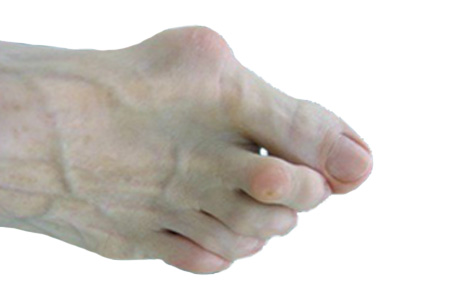What Causes Bunions?
Bunions develop from abnormal foot structure and mechanics, which place an excessive load on the 1st metatarsal. This leads to stretching of supporting soft tissue structures with the end result being gradual deviation of the 1st metatarsal.
As the deformity increases, there is an abnormal pull of certain tendons, which leads to the drifting of the great toe toward the 2nd toe. At this stage, there is also adaptation of the joint itself that occurs.
Shoes are often blamed for creating these problems. This, however, is inaccurate. It has been noted that primitive tribes where going barefoot is the norm will also develop bunions.

SYMPTOMS
The most common symptoms associated with this condition are pain on the side of the foot.
Shoes will typically aggravate bunions. Stiff leather shoes or shoes with a tapered toe box are the prime offenders. The bunion site will often be slightly swollen and red from the constant rubbing and irritation of a shoe.
Occasionally, corns can develop between the 1st and 2nd toe from the pressure the toes rubbing against each other.
On rare occasions, the joint itself can be acutely inflamed from the development of a sack of fluid over the bunion called a bursa. This is designed to protect and cushion the bone. However, it can become acutely inflamed, a condition referred to as bursitis.
TREATMENTS
Early treatment of bunions is centered on providing symptomatic relief.
Switching to a shoe with a rounder, deeper toe box and made of a softer more pliable leather will often provide immediate relief.
The use of pads and cushions to reduce the pressure over the bone can also be helpful for mild bunion deformities.
Custom made foot orthoses are also used for conservative treatment of bunions. They work by reducing the pressure along the first ray. These may help reduce pain in mild bunion deformities and slow the progression of the deformity.
When these conservative measures fail to provided adequate relief, surgical correction is indicated.
How can Firefly Foot & Ankle Clinic help ?
At Firefly we can advise on suitable footwear and inform you about how to suitably cushion the bunion to reduce pain. We can advise and prescribe exercises designed to strengthen the Abductor Hallucis muscles to help realign the big toe and prevent it crowding the four smaller toes.
Where suitable we can prescribe orthotics. By changing the axis of the subtalar joint, orthoses can remove pressure from the big toe joint, relieving pain. Studies have found, in 50% of cases bunions respond positively when the patient is prescribed custom foot made orthotics based on the patient’s biomechanical findings.
In severe cases, Firefly’s Podiatric team will advise on the merits of surgical intervention.



